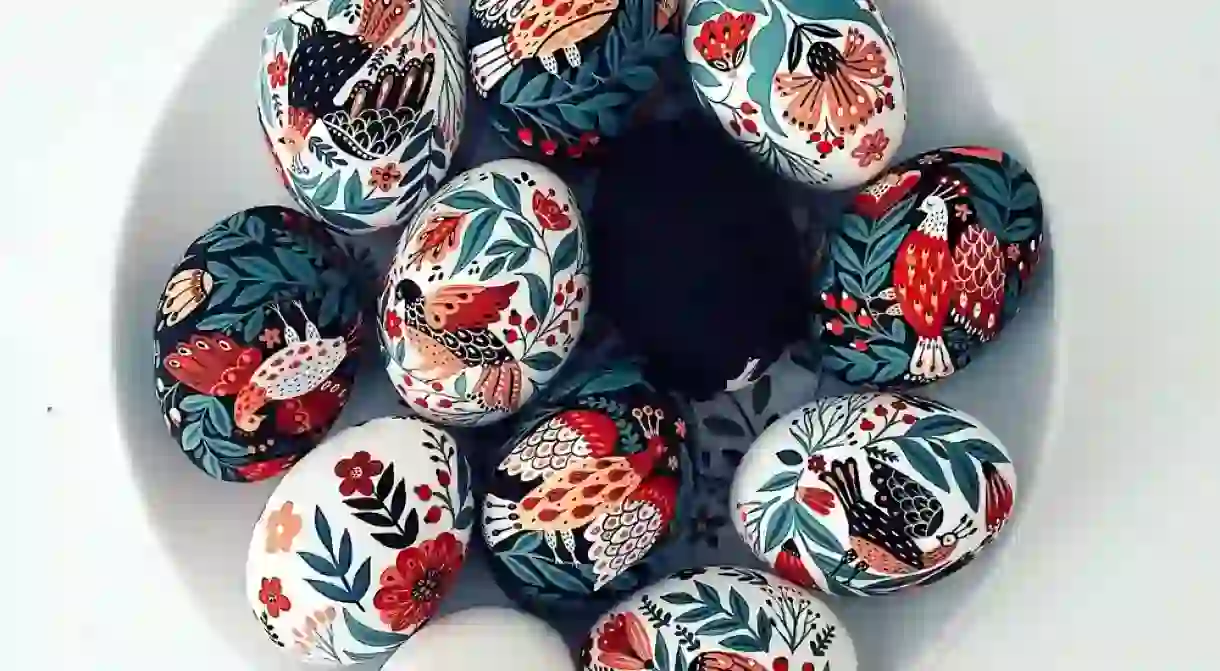These Are the Most Beautiful Easter Eggs You Have Ever Seen

Designing everything from limited edition prints and book covers to kitchenware and bracelets, the self-taught Uzbekistani illustrator Dinara Mirtalipova might now call snowy Ohio home, but the Soviet Uzbek culture of her homeland is a constant inspiration for her beautifully painted Easter egg series.
Drawing upon folkloric motifs, Mirtalipova has crafted a unique illustration style that is distinctly colorful and full of vitality. Although she studied Computer Science at Tashkent State University of Economics, her real passion was always illustration, and now she works out of her Sagamore Hills home studio. Using a range of materials and tools, including carving lino blocks and using gouache, Mirtalipova creates everything from stunning fabric designs and art prints to greetings cards, wrapping paper, and even badges.
In addition to her extraordinary hand-crafted pieces, the painted Easter egg has been a constant source of inspiration. We asked Mirtalipova if she could tells us a little about her beautiful hand-painted series.

Culture Trip: When did you start painting eggs?
Dinara Mirtalipova: Painting eggs for Easter is a family tradition, started by my grandma Lilia. She celebrated Easter and baked Easter bread called kulich (кулич). As a child I loved to watch her doing it and I loved to help with dying eggs. After she passed away, I continued to decorate eggs for Easter year after year and now it’s become my tradition.

CT: Is this a traditional aspect of Uzbekistan culture?
DM: No, Uzbekistan is a melting pot of many cultures and traditions, or at least it used to be when I lived there as a child. Right after the Second World War, Uzbekistan became a home for people of different ethnic and religious backgrounds. It was a place where Christians, Jews, Muslims and Buddhists lived in solidarity and respected all the traditions. I grew up in a mixed family myself. My grandma Hodjia was a Muslim, while my other grandma, Lilia, was a Christian. So growing up, we celebrated both holidays.

CT: How did your painted Easter egg series come about?
DM: Years ago I used to paint on blown out eggs, but they were super fragile and didn’t last long. After I discovered wooden and porcelain eggs at a local crafts store, I decided to paint one each year. Later, other people started commissioning me to paint an egg. So this year, I decided to do a signed collectible series.
CT: What informs your designs and patterns?
DM: Since Easter is a spring holiday, birds and flowers fit so well as they represent spring.

CT: How long do the eggs take to make?
DM: They truly do take very long. I start them early in the year and take my time painting every little element and enjoying every brush stroke. I also do it in between my other illustration projects. It’s my way to relax when I feel my routine becomes too structured. The hardest part is to know when to stop, because I can keep on adding detail after detail.
CT: How many do you make?
DM: This year I made a full dozen.

CT: Do particular places inspire your work?
DM: I know it sounds too obvious, but inspiration hides everywhere. I love taking nature walks with my daughter, I love listening to ethnic music, taking trips to museums or libraries, I love collecting fabric, ethnic dolls and coins. So it’s hard to name one destination, I think it depends on what you’re looking for.

CT: Who are your favorite illustrators and designers?
DM: Since folk art is mostly intuitive, I—like many folklorists—don’t have a traditional art education, meaning I didn’t study art history like many artists do. I paint my way, but then I may stumble upon a lovely book and that becomes my “a-ha!” moment. For myself I look at William Morris, Josef Frank, Mary Blair, Walter Crane and many, many other giant masters.

CT: What’s it like living and working in Ohio?
DM: While most will say Ohio is boring, I will insist it’s the quietness that I fell in love with. The nature is beautiful, there are many parks that bloom in spring and summer. Usually the winters are pretty snowy and cold, however the past few were a joke!

CT: How much does America inspire your work? The cultural landscape, the arts community in Ohio, etc.
DM: When I first moved to the US, America seemed a lot different. I guess that was a cinema-influenced perspective where, as a new immigrant everything, seems fancy and Hollywood like. But as I settled, I discovered a different America—a more traditional one, the one that respects the environment and family values, I discovered American folk art for myself, and the love for quilting. I’ve been to different places in the US where culture is very unique and captive, like for example it’s just not possible to compare Texas to New York, or Ohio to California.

CT: What do you miss the most about Tashkent?
DM: I miss the old Tashkent—the one where the streets are narrow and the old neighborhoods with clay houses where my grandmas lived. I hear from people that the city is unrecognizable now—it’s more modern, decorated with new buildings and roads. But I guess I’m nostalgic for the old times.

CT: What do you miss the least?
DM: Growing up I couldn’t wait to leave my parents’ nest and be able to travel the world and make my own decisions. So I guess I don’t miss the part where I was dependent.

See more of Dinara Mirtalipova’s work on her website or her Instagram account.













